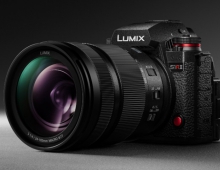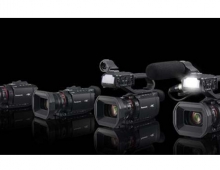
Matsushita Electric (Panasonic) introduces new DMR-E50 and DMR-E60 DVD-R/RAM recorders
Matsushita Electric Industrial Co., Ltd. (NYSE: MC), best known for its Panasonic-brand products, today announced the release of the DMR-E50 and DMR-E60, two fourth-generation DVD-RAM recorders that support recording on both DVD-RAM and DVD-R discs. They will each be released simultaneously worldwide, with the DMR-E50 to be available in March 2003 and the DMR-E60 within the next six month.
The Panasonic DMR-E50 and DMR-E60 allow consumers to record superb digital video onto DVD-RAM and DVD-R1 discs quickly and easily. They support both DVD-RAM and DVD-R discs, providing the best of both worlds: DVD-R for the highest compatibility, allowing consumers to share video recordings with virtually anyone with a DVD player; and DVD-RAM for rewritability and benefits like Time Slip™, 'Chasing Playback', and 'Simultaneous Play and Record'. DVD-RAM offers the perfect solution for recording and re-recording favorite programs—over 100,000 times on the same disc.
"This past year the industry has seen tremendous growth in DVD recorders, and Panasonic expects products like the DMR-E50, the DMR-E60 and combination DVD-hard disk recorders to bring DVD recording into the mainstream in 2003," says Tokikazu Matsumoto, director of the Home AV Business Unit, Panasonic AVC Networks Company, at Matsushita Electric. "More and more consumers understand the advantages of recording onto DVD, such as simultaneous recording and playback, instant access, ease-of-use, huge storage capacity, and the long lifetime of the media. As products in this category become more affordable, a DVD recorder will surely become a must-have product for the average consumer."
The feature-rich DMR-E50 and DMR-E60 offer users the benefits of progressive scan, chasing playback, enhanced time-shifting, simultaneous record and playback, instant access, and on-disc video editing. When connected to home theater components, the recorders enable consumers to enjoy multiple digital entertainment formats, including DVD video, music CDs, CD-R, and CD-RW2 discs. The unit also supports MP3.
With a Panasonic DVD recorder consumers can watch what they want, when they want. In addition to having the ability to automatically record and instantly access favorite television shows, consumers can watch last week's episode of their favorite show while recording this week's, from the same disc at the same time.
With instant recording onto a DVD disc, there's no need to have to find blank space as with a VHS tape. Just press record and the unit will automatically find space on the disc, much like a hard disk drive. Panasonic's unique Time Slip™ feature allows viewers to replay a scene recorded earlier without disrupting the recording process, simply by touching a button on the remote (in 30 second increments). Chasing playback allows users to watch a show in progress while it's being recorded. The user can watch right from the beginning, while the show continues to record to the end.
Consumers can easily transfer their favorite VHS tape recordings to space-saving discs. Personal movie libraries and family videos can be archived, preserved, easily cataloged and accessed, and even edited right from the disc. The DMR-E50 and DMR-E60 also feature progressive scan, for optimum picture quality when viewing DVD movies.
In addition, the Panasonic DMR-E60 can be used for storing and viewing digital photos using a SD/PC card slot. It also features a DV input terminal to allow direct transfer of images from a digital video camcorder to DVD-RAM. The playlist function allows easy editing without the need to use a PC.
The DVD video recording technology used in these new DVD-RAM recorders complies with the DVD-RAM recording formats standardized by the DVD Forum. DVD-RAM provides a single format for computer data and video-based applications. The format offers high storage capacity on removable media, high-speed data transfer, exceptional picture and sound quality, fast, random access, and rewritability up to 100,000 times.
The executive speeches and presentations at the press conference can be seen with webcast of audio and moving image at the following URL: http://www.panasonic.co.jp/global/top.html
The web cast will start at 10am on February 6 (Japan time) and continue through March 11.
The Panasonic DMR-E50 and DMR-E60 allow consumers to record superb digital video onto DVD-RAM and DVD-R1 discs quickly and easily. They support both DVD-RAM and DVD-R discs, providing the best of both worlds: DVD-R for the highest compatibility, allowing consumers to share video recordings with virtually anyone with a DVD player; and DVD-RAM for rewritability and benefits like Time Slip™, 'Chasing Playback', and 'Simultaneous Play and Record'. DVD-RAM offers the perfect solution for recording and re-recording favorite programs—over 100,000 times on the same disc.
"This past year the industry has seen tremendous growth in DVD recorders, and Panasonic expects products like the DMR-E50, the DMR-E60 and combination DVD-hard disk recorders to bring DVD recording into the mainstream in 2003," says Tokikazu Matsumoto, director of the Home AV Business Unit, Panasonic AVC Networks Company, at Matsushita Electric. "More and more consumers understand the advantages of recording onto DVD, such as simultaneous recording and playback, instant access, ease-of-use, huge storage capacity, and the long lifetime of the media. As products in this category become more affordable, a DVD recorder will surely become a must-have product for the average consumer."
The feature-rich DMR-E50 and DMR-E60 offer users the benefits of progressive scan, chasing playback, enhanced time-shifting, simultaneous record and playback, instant access, and on-disc video editing. When connected to home theater components, the recorders enable consumers to enjoy multiple digital entertainment formats, including DVD video, music CDs, CD-R, and CD-RW2 discs. The unit also supports MP3.
With a Panasonic DVD recorder consumers can watch what they want, when they want. In addition to having the ability to automatically record and instantly access favorite television shows, consumers can watch last week's episode of their favorite show while recording this week's, from the same disc at the same time.
With instant recording onto a DVD disc, there's no need to have to find blank space as with a VHS tape. Just press record and the unit will automatically find space on the disc, much like a hard disk drive. Panasonic's unique Time Slip™ feature allows viewers to replay a scene recorded earlier without disrupting the recording process, simply by touching a button on the remote (in 30 second increments). Chasing playback allows users to watch a show in progress while it's being recorded. The user can watch right from the beginning, while the show continues to record to the end.
Consumers can easily transfer their favorite VHS tape recordings to space-saving discs. Personal movie libraries and family videos can be archived, preserved, easily cataloged and accessed, and even edited right from the disc. The DMR-E50 and DMR-E60 also feature progressive scan, for optimum picture quality when viewing DVD movies.
In addition, the Panasonic DMR-E60 can be used for storing and viewing digital photos using a SD/PC card slot. It also features a DV input terminal to allow direct transfer of images from a digital video camcorder to DVD-RAM. The playlist function allows easy editing without the need to use a PC.
The DVD video recording technology used in these new DVD-RAM recorders complies with the DVD-RAM recording formats standardized by the DVD Forum. DVD-RAM provides a single format for computer data and video-based applications. The format offers high storage capacity on removable media, high-speed data transfer, exceptional picture and sound quality, fast, random access, and rewritability up to 100,000 times.
The executive speeches and presentations at the press conference can be seen with webcast of audio and moving image at the following URL: http://www.panasonic.co.jp/global/top.html
The web cast will start at 10am on February 6 (Japan time) and continue through March 11.





















